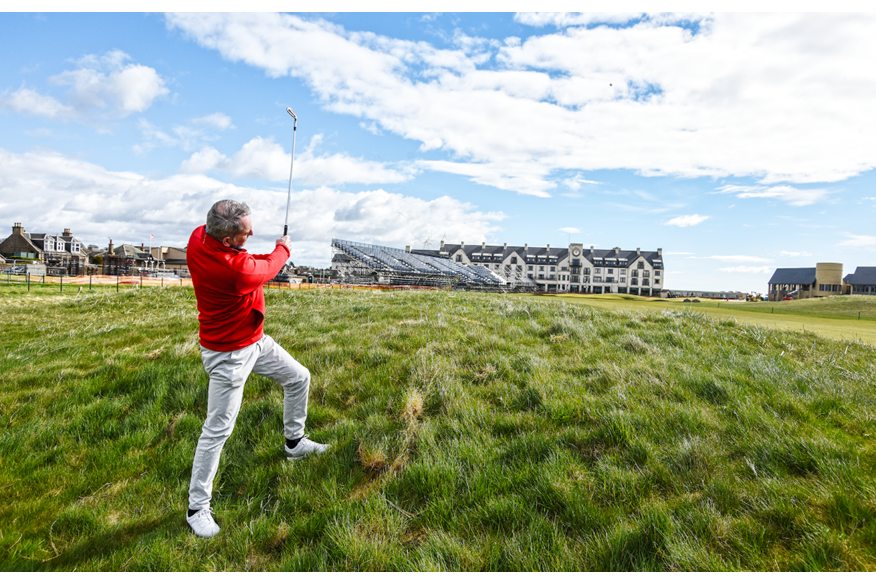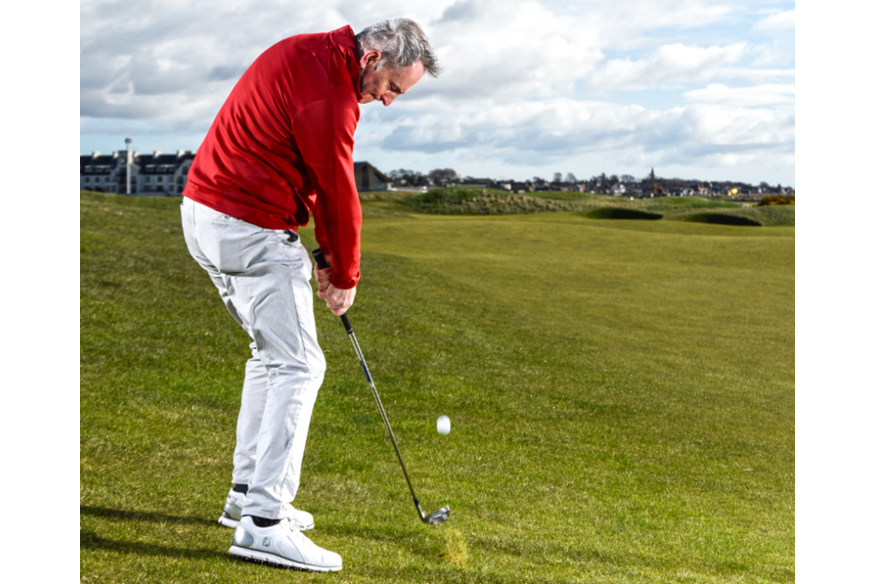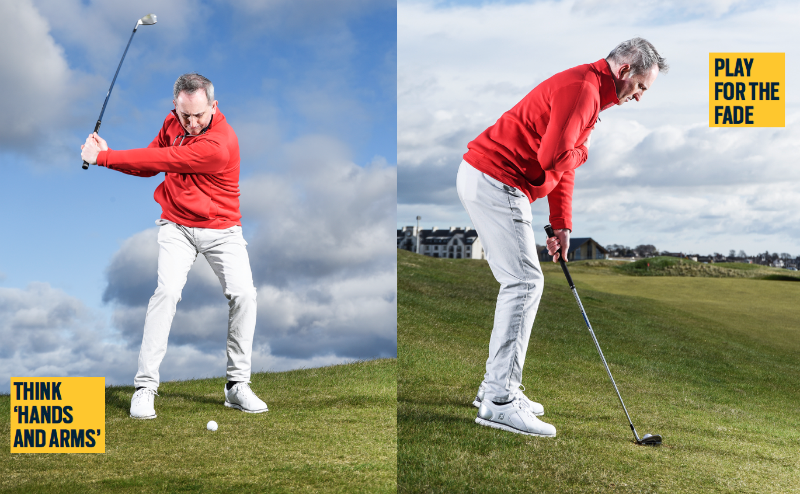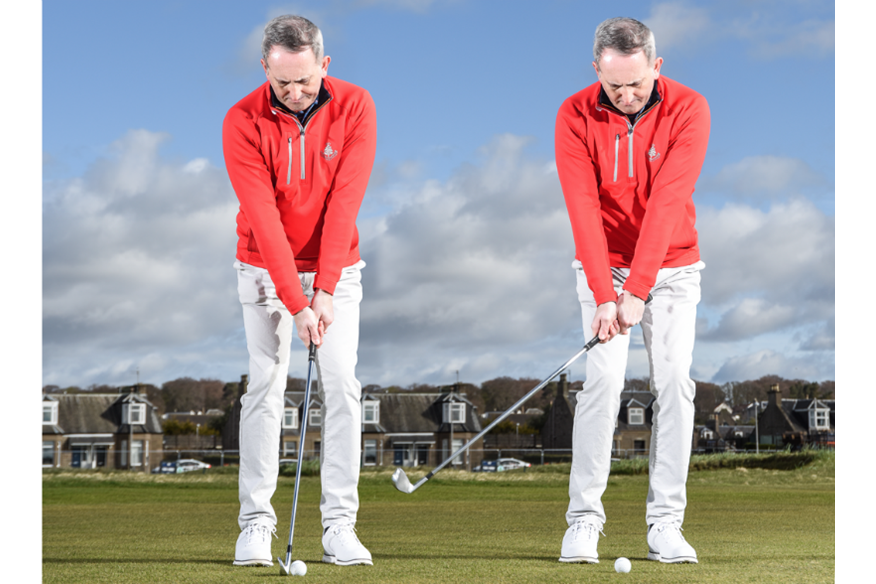2018 Open: Five Shots the winner will need… and how to play them
Last updated:
Carnoustie is regarded as one of – if not the – toughest courses among the 10 on The Open Championship rota. The winner in July will need to navigate more than 110 bunkers, the constant winds that whip off the North Sea and the notorious Barry Burn…
In order to conquer this course, they will need to play several shots consistently well – clearing the lips in the traps, driving the ball under the wind, and chipping from tight lies. Below, Carnoustie Head Pro Colin Sinclair will show you how they’ll do it with five different shots, but first we asked him what key attributes are needed to tame Car-Nasty.
“Quality ball-striking, patience and good strategy,” says Sinclair. “Luck also plays a part because if the wind is blowing easterly, the course will play three to four shots tougher than it would in a prevailing, westerly breeze.
“The first third is where you make your score. The second third is all about consolidating what you’ve got and not taking any risks, because the last thing you want to do is chase on the last six holes. Any player who pars in will be gaining shots on the field.”
Read on below to see how to play the key shots needed around the 147th Open venue.
1: Getting out of pot bunkers: “Open the face to clear the steepest of lips”
With 111 bunkers littered across all 18 holes, anyone who plays at Carnoustie is almost guaranteed to find one (or more) at some point. If you find one of the famous Spectacles bunkers guarding the approach to the par-5 14th, it can be difficult to even see the face, let alone clear it.

The safe option is to take your medicine and knock it out sideways, or even backwards. But if you need to make a score and the ball is sitting far enough back, getting out is actually a lot easier than it looks. A few simple tweaks to your set-up will give you the height you need to pop it out and on to the putting green.
To get the ball up quickly, you need two things: loft and speed. To get the height, use the most lofted club in your bag and set the face open so the grooves point to the sky. With the shaft angled forwards slightly, position the ball a fraction inside your left heel and swing wide to promote a shallow angle of attack. This will get the club sliding through the sand without any resistance and help to present the sole’s trailing edge at impact, which is crucial for keeping loft on the face.
KEEP THE CLUBHEAD MOVING
Whenever you’ve got a long bunker shot, don’t just thump the sand and stop there. To generate the clubhead speed required to blast the ball up and out, you need to take less sand and commit to a full release. Aim to nip the ball off the sand and then accelerate through to a shoulder-high finish.
STAY LOW
When opening the face at address, don’t feel like you need to aim left and swing left. Simply lowering your hands will flatten the shaft and get the face pointing straight up, rather than right of target.
TRY TO MIMIC YOUR SET-UP POSITION AT IMPACT
Most amateurs who thin the ball into the face do so because they are leaning back and trying to scoop the ball to add extra loft. Your set-up and club will do that for you, so just focus on keeping your body angles and weight distribution (55/45) constant.
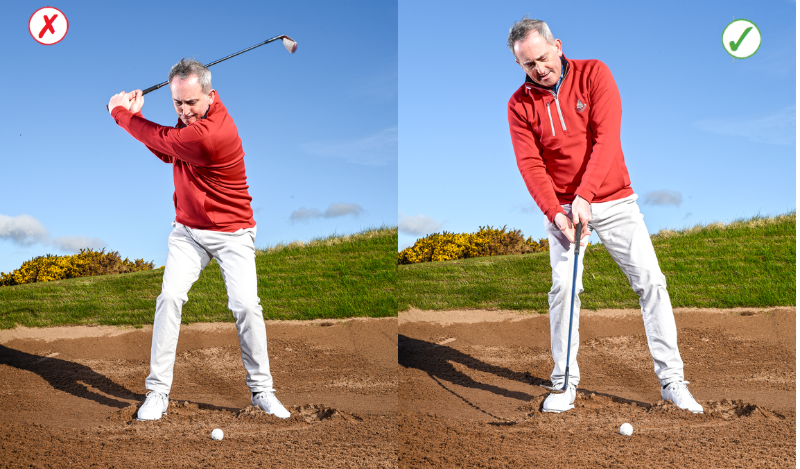
2: Keep it low off the tee: “Drive the ball under the wind”
Four of the first seven holes normally play into and across a prevailing wind, and call for a low stinger to take advantage of the fast and firm running fairways. Tiger Woods is a master at keeping the ball under the wind, but most amateurs lose distance and accuracy because they think to hit it low you need to tee the ball down.

But TrackMan has taught us that striking the ball lower on the face produces more backspin, causing the ball to balloon and stall in the air. For a more penetrative flight, you need to hit it higher on the face and feel like you’re compressing the ball by hitting down on it.
SWING WITHIN YOURSELF
The harder you hit the ball, the more spin you generate. A shorter, more rhythmical swing will help take spin off, so aim to finish low to hit low. Watch how Tommy Fleetwood abbreviates his follow through, and try to copy that position.
KEEP IT SIMPLE
If the wind is really strong, stand wider for extra stability and choke down for more control. Playing the ball back in your stance a fraction will also help to encourage a downward blow, and to deloft the face.
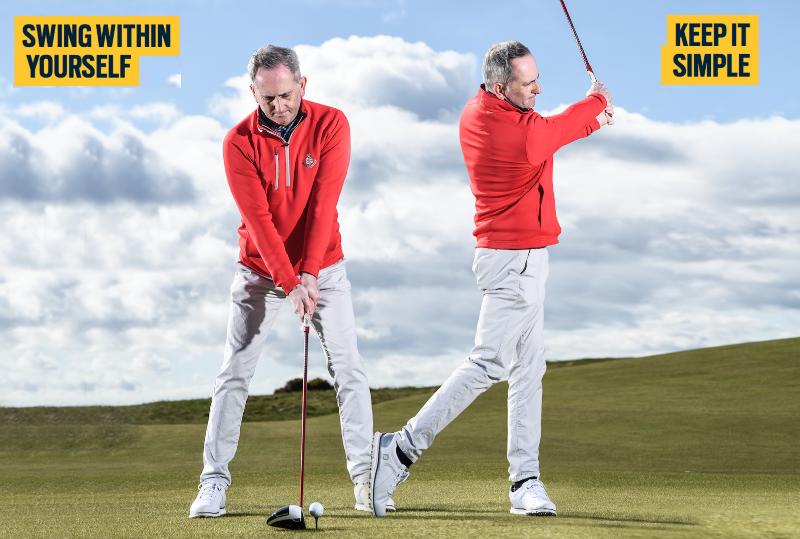
3: Stay Balanced On The Slopes To Escape The Rough
The average European Tour pro hit the fairway 60% of the time last year, which means nearly half the time they were trying to hit their approach from the rough. What makes this even more challenging at Carnoustie are the undulations and mounds which give you something else to think about.
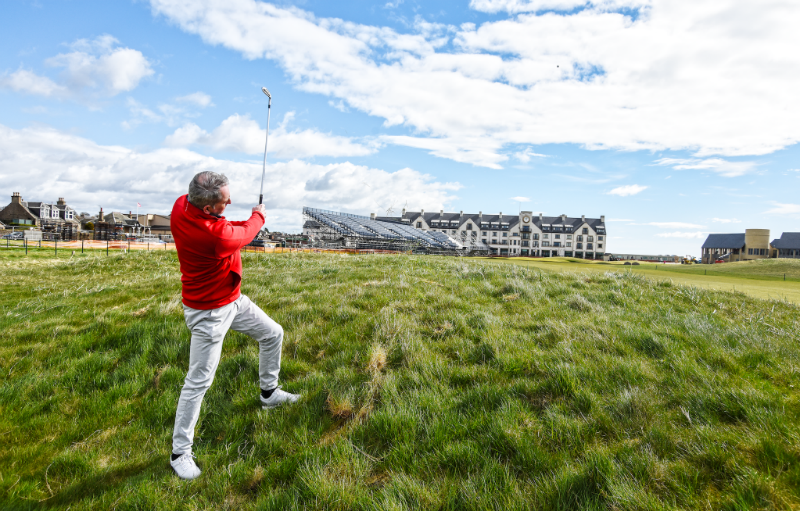
Where most golfers go wrong is that they forget to set the body perpendicular to the slope they’re hitting from when hacking out of the thick rough. This is particularly hard to do if your hitting from an upslope (a common feature on the 18th) because your body will want to lean into the slope to stop falling back, which then causes the club to dig in. As with any awkward lie, you need to maintain your spine angle at address and impact to deliver the club on plane.
A simple way to do this is by making a shorter swing – led by the hands and arms – and holding off the release for extra control. By not thrashing at the ball, this will give you a far better chance of keeping your shoulders parallel to the slope.
ASSESS THE LIE
If the ball is sitting deep, don’t risk keeping the ball in the long grass by getting greedy. If you’ve got shots to play with, pick a high-lofted club and get it back in play. To accommodate the clubface twisting in the rough and closing the face, just grip a little tighter and aim farther right.
DON’T TAKE ANY CHANCES
How many times have you grounded the club in the rough and moved the ball by accident? To avoid being called up on this in competition, get into the habit of hovering the club above the ball. Not only will this make your takeaway smoother but it will also produce a steeper angle of attack, which will minimise how much grass is caught between the face and ball at impact.
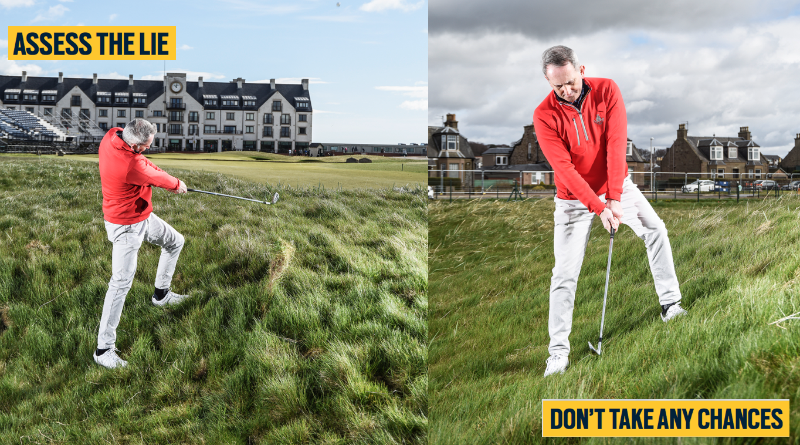
4: Hit More Greens When The Ball Is Sitting Below Your Feet
Another shot most golfers struggle with and encounter a lot on links courses is when the ball sits below their feet. Naturally, gravity wants to pull you down the slope and the tendency is to jump up, causing thins or tops. To prevent this, you need to flex the knees more so the chest stays on top of the ball.
From here, try to keep the weight on the balls of your feet and your backside low to the ground throughout the swing. Doing so will restrict how much your body can turn, so again let your hands and arms dictate the swing to improve your quality of strike.
THINK ‘HANDS AND ARMS’
Completing a full body turn is almost impossible from this squatted position, and unnecessary if you want to swing from a stable base. To avoid being thrown off balance, swing within yourself and club up to compensate for a shorter swing.
PLAY FOR THE FADE
The ball flight will naturally follow the gradient of the slope, so aim further left to allow for a left-to-right shot shape. How much depends on the severity of the slope.
5: Bump & Run: Chip like you putt
At 248 yards, the par-3 16th is one of the hardest greens to hit on The Open rota. The trouble on the right means it’s easy to bail out left, which leaves little option but to use the sloeps and undulations to get up and down.
The tight lies and wind make hitting a flop or pitch incredibly risky, hence a bump or run is the sensible and safest play. Treating it like a putt is the secret to getting it lcose, and this needs to be reflected in your set-up and swing.
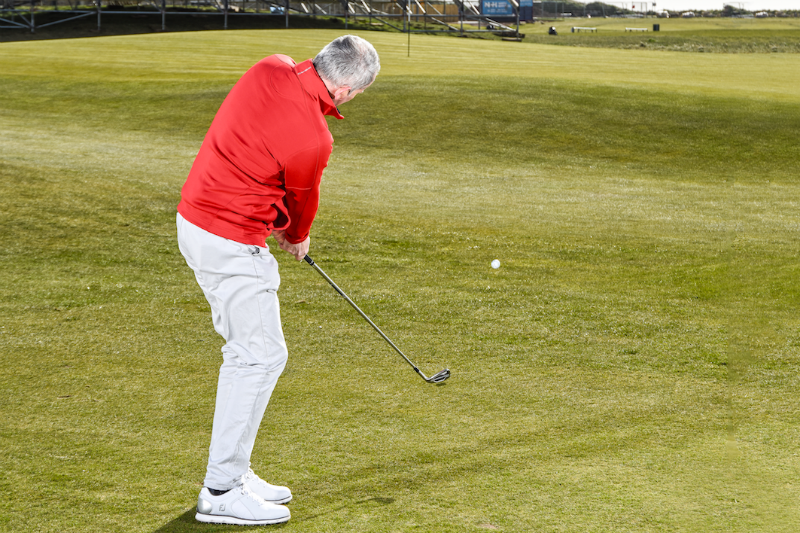
FOCUS ON YOUR LANDING POINT
Start by reading the contours of the land and then aim for the flattest part so the ball rolls true and onto the green as quickly as possible. Select your club accordingly (a mid-iron is best for a bump and run) and set up as you would a putt. With the shaft sitting at a more vertical angle, choke down the grip for added control and then rock the shoulders back and forth to replicate a putting stroke.
TAKE THE SPIN OFF
Unlike a pitch, the wrists should hinge only slightly to promote a lower trajectory. Leaning the hands forward slightly will also help to deloft the face, and prevent any scooping action which leads to fats and thins.
A DRILL TO TRY ON THE RANGE
Many amateurs suffer from poor distance control because their hands stop releasing after impact. To fix this, picture a clockface with your feet straddling the six o’clock position. Start by swinging your hands back to nine o’clock and then forwards to three o’clock, and note how far the ball goes. As you shorten your swing, your hands should stop an hour earlier in the backswing and finish an hour later in the follow through. The idea is to swing to these positions consistently so you can build three stock yardages for every club.
